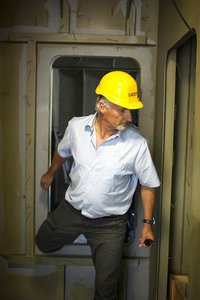The Aurora research vessel contributed to a breakthrough in the case of the dead journalist Kim Wall
Aarhus University's research vessel Aurora has helped the police in Copenhagen make a breakthrough in the case in which submariner Peter Madsen has been charged with the murder of the Swedish journalist Kim Wall, who lost her life on board the UC3 Nautilus submarine. The Aurora helped with the calculation of historical data for tidal and wind conditions.

Captain of the Aurora advanced research vessel, Torben Vang, and his crew are now on the way to Skagen where they will put the finishing touches to their work of mapping some habitat conditions in Skagerak.
Just one example of the many different research and monitoring tasks that the Aurora is hired to do. But even though the vessel often has different tasks, last Thursday and Friday was the first time the Aurora took part in a murder investigation, and one that is being intensively covered by international media because of the spectacular circumstances.
Called in to the investigation
The Aurora was called in to the investigation when Torben Vang received a phone call from the Copenhagen Police, who wished to make use of the know-how that the captain and his crew could offer. And also take advantage of the very sophisticated research equipment found on board the Aurora.
"I was asked whether we could assist the police in locating the missing body parts and when I indicated that we might be able to contribute with the knowledge which the crew as a whole possess and the technological possibilities we have with our equipment, we were requisitioned by the Copenhagen Police," he explains.

Aurora's captain Torben Vang. Photo: Lars Kruse.
At a press conference on Saturday morning, Police Inspector Jens Møller Jensen from Copenhagen Police had the following to say about the Aurora's efforts:
"Yesterday, with the assistance of the Navy’s minesweepers and Aarhus University's research vessel Aurora, we carried out a number of dives, as we’ve done on both Thursday and Friday in Køge Bay. Yesterday morning this led to us initially finding a bag containing Kim Wall’s clothes – her jumper, skirt, socks and shoes. The same bag also contained a knife and some lead weights to keep it submerged. Around noon we found first one leg and then a further leg. Shortly afterwards we found a head that also lay in a bag that was weighed down by several pieces of metal."
The police inspector also told the press conference that the police hypothesis throughout has been that the missing body parts from Kim Wall should be found in the area of Køge Bay in which they yesterday succeeded in locating the legs and head. Explaining the background for the police hypothesis, he said that the investigation had previously revealed that the Nautilus submarine was submerged from around 04:40 until 08:25 on the night of Friday 11 August. After this, the submarine surfaced again and alternatively drifted and sailed for an additional forty minutes until 9:05.
Salvaged on board the Aurora
"It’s the route that the Nautilus travelled from 08:25 until 09:05 that we’ve been greatly interested in because the hypothesis has been that Kim was dismembered during the four hours that the submarine was submerged," said Møller Jensen at the press conference.
The body parts from Kim Wall’s corpse that were recovered and salvaged on board the Aurora were located approximately one kilometre south of the location where the Swedish dogs trained to work in water, which were also involved in the investigation, had reacted the most.
"This is also why it’s taken a while (to find the body parts, ed.). We now have some experience of working with both divers and the specially trained Swedish dogs that we didn’t have initially. No one thought that the scent from the body parts could travel so far and we’ve initially searched somewhat closer than the thousand meters."
Fresh eyes and a scientific approach
It is here that AU’s research vessel has provided an important piece in the large jigsaw puzzle that must be pieced together in such a complicated investigation.
"We bring fresh eyes and a scientific approach. For example, we look at uncertainties as probabilities, so we contribute to the investigation in this way," says Vang.
Talking about the Aurora's efforts on Thursday and Friday, Police Inspector Møller Jensen told the press conference:
"What Aarhus University and their ocean environment vessel have been able to help you with is to use some historical data about currents as the basis for making calculations based on where the dogs have reacted and the known current conditions in Køge Bay on 11 August. And they (the Aurora, ed.) actually came up with a location close to the where the body parts were found and said to us that it was possible to search all the way down here.”
At the press conference, the police inspector confirmed that the police will continue the search for body parts – which is to say the arms – that they have so far failed to find.
"Of course, we’re doing this for the sake of the investigation, but equally from an ethical perspective so that the relatives can have a whole person when Kim Wall is to be buried."
However, according to Torben Vang, the Aurora will not take part in that part of the search.

